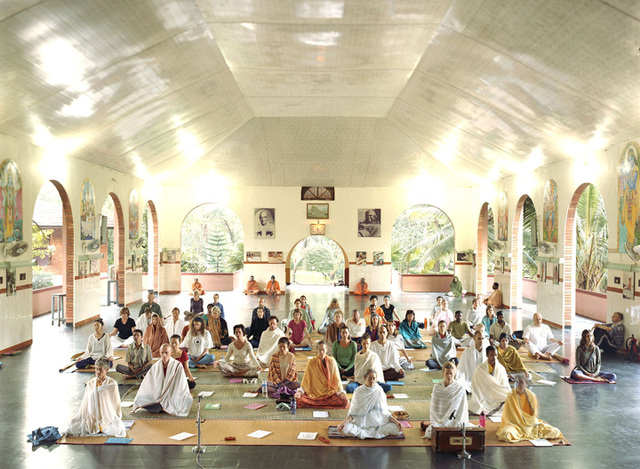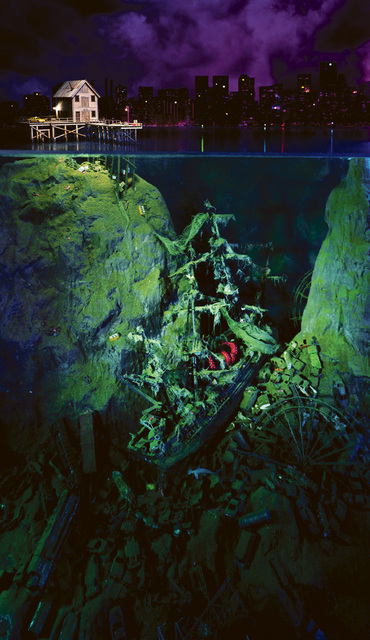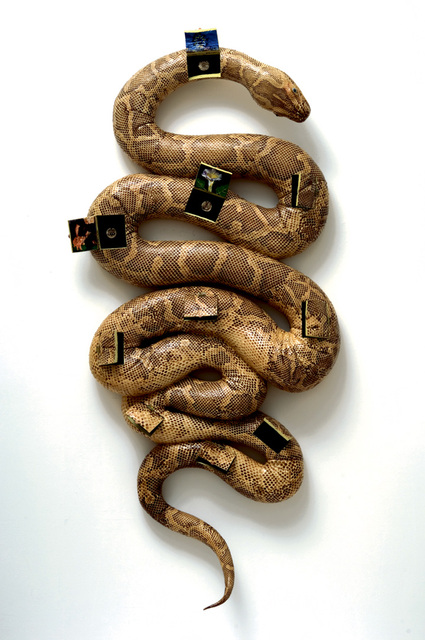Andrew Bird’s Armchair Apocrypha is a near-perfect album. It’s crept onto my mix albums, my iPod, my car and my home stereo. I’m listening to it now. I might be obsessed. It’s one of those albums that throws light throughout a creative labyrinth in which new ideas emerge, creating a generous lyrical and musical iron lung (in the best sense). It lacks the irony or cynicism that would make two or three listens too many and instead invites something like belief from the audience. But for all its spacey, finger-picked loveliness, it’s a work of realism, couched in mortal inevitability and certitude.There’s a similar ethos percolating under the surface of the shows now at 516 Arts. At street level, Holly Roberts curates Cautionary Tales: A Visual Dystopia . The artists in the show trade in ruin and decline, making work that—while not truly anxiety-ridden—reflects the state of things. Whether it’s Erika Wanenmacher’s creepy and amazing Coyote’s Suit to Disguise Himself As Me or Lori Nix’s photographs of her meticulously constructed sets of libraries and shipwrecks, the work of each artist comes out of (or points to) a dark, phobic worldview.In her curator’s statement, Roberts notes that “like canaries in the coal mine, all of these artists are trying to signal warnings about the state of things. But as bleak and frightening as these images may be, there is tremendous visual beauty and power in them as well.” Aside from the work of Wanenmacher or Roger Ballen—the latter’s pseudo-pathogenic images are calmly baleful—I’m not entirely won over by the assertion that these are sentinel artists signaling the end times or doomsday. The artistic derivatives supplied by the artists, while beautiful, are just vague or detached enough to cripple a truly sepulchral reading. Most of the work is too much about art to be an effective alarm. And that’s OK, because the stories shared by the artists are engaging and ultimately rewarding visual experiences.Though mostly photographs, the work is varied and wide-ranging. Jeff Gibson’s collage paintings greet you at the door, their hybrid forms running between Roman coin and graffiti. They look across Becky Holtzman’s giant book work, Groundswell , a compendium of poetry that stands in reaction to the work in the show (as highlighted in Poetry News, "STIR: A Festival of Words," Sept. 11-17). Emily Trovillion’s foregrounded paintings pointedly echo German Expressionism but have a stripped-down feel, where the smaller set of relationships enforce a sense of isolation and revelation. In Tuatara with Gourd , Robert Sulkin melds bits of figurative painter Francis Bacon into his constructions of animal remains. All of these artists—including Rhiannon Mercer, Robert Hirsch, David Ondrik, Laurie Tümer, William Wilson and Cathy Wysocki—focus on the many creative ways we destroy the world around us or are victims of that destruction. Environmental awareness, war and the displacement of Native peoples each find their way into the artist’s crosshairs. Hallelujah, I yelled in my head as I made my way to the second floor. Spread before me was Finding a Pulse , a show in which the artists offer up hope rather than gloom and doom. Co-curated by Rhiannon Mercer and John Photos, Finding a Pulse isn’t a simple antidote to the hard-hitting images and forms downstairs. The show surprises through its mix of submitted work and invited artists; with few exceptions, most of these artists haven’t shown in Albuquerque, which gives the exhibit that new car smell and subverts most viewing expectations. As a whole, the work in the show is less about hope and simply about the construction of inhabitable forms. In contrast to Cautionary Tales , it stands less as a reflection on outcomes—a choice between deaths—but as a decision on a certain type of question. The work doesn’t reaffirm that destroying the Earth is a bad thing, which we all know. Instead, it asks how we can turn our creative selves into talismanic beams that somehow cut through the shit we’ve piled onto us. And this happens throughout. From the satisfaction of looking at Howard Fonda’s Untitled quilt painting at the top of the stairs to D’Jean Jawrunner’s peculiar iron towers at the back of the space, each artist is revealing their cartographic impulses, proffering decoder rings that open new paths in the world. There’s just enough of it in the show. The Unabomber vibe in Jeff Eisenberg’s drawings meshes well with Hans Gindlesberger’s cinematic stills. Sasha Bezzubov and Jessica Sucher’s images of spiritual tourism in India are flat-out stunning, especially because I found them far from exploitative. No doubt that opinion flavors every document (thank you, Errol Morris), but these images don’t seem driven by art school aesthetics but rather a simple survey of spiritual quests.There’s a whole solar barge I could fill with things to say about each of these shows and the artists in them—my admiration continues to grow for John Wenger’s work—and the complexities they promote and maintain are vital and expansive.It’s a constant swing between the belief in light and dark, in spite of the inevitable. In the words of Andrew Bird: “Grab hold of your bootstraps and pull like hell.”
516 Arts (516 Central SW, 242-1445) presents Cautionary Tales: A Visual Dystopia and Finding A Pulse through Oct. 18. For further details, visit 516arts.org. David Leigh is the director of the College of Santa Fe Fine Arts Gallery.











